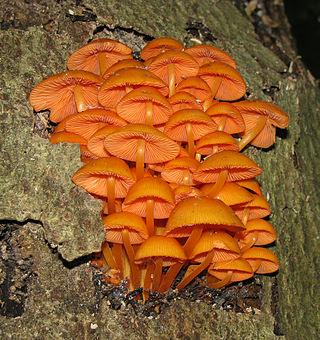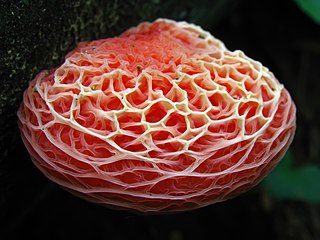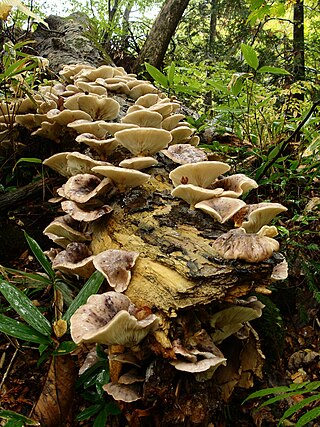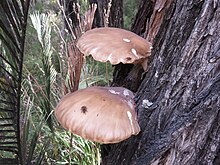
A mushroom or toadstool is the fleshy, spore-bearing fruiting body of a fungus, typically produced above ground, on soil, or on its food source. Toadstool generally denotes one poisonous to humans.

Pleurotus ostreatus, the oyster mushroom, oyster fungus, hiratake, or pearl oyster mushroom is a common edible mushroom. It is one of the more commonly sought wild mushrooms, though it can also be cultivated on straw and other media.
Fungiculture is the cultivation of fungi such as mushrooms. Cultivating fungi can yield foods, medicine, construction materials and other products. A mushroom farm is involved in the business of growing fungi.

Pleurotus eryngii is an edible mushroom native to Mediterranean regions of Europe, the Middle East, and North Africa, but also grown in many parts of Asia.

Pleurotus is a genus of gilled mushrooms which includes one of the most widely eaten mushrooms, P. ostreatus. Species of Pleurotus may be called oyster, abalone, or tree mushrooms, and are some of the most commonly cultivated edible mushrooms in the world. Pleurotus fungi have also been used in mycoremediation of pollutants, such as petroleum and polycyclic aromatic hydrocarbons.

Omphalotus nidiformis, or ghost fungus, is a gilled basidiomycete mushroom most notable for its bioluminescent properties. It is known to be found primarily in southern Australia and Tasmania, but was reported from India in 2012 and 2018. The fan or funnel shaped fruit bodies are up to 30 cm (12 in) across, with cream-coloured caps overlain with shades of orange, brown, purple, or bluish-black. The white or cream gills run down the length of the stipe, which is up to 8 cm (3 in) long and tapers in thickness to the base. The fungus is both saprotrophic and parasitic, and its fruit bodies are generally found growing in overlapping clusters on a wide variety of dead or dying trees.

Mycena leaiana, commonly known as the orange mycena or Lea's mycena, is a species of saprobic fungi in the genus Mycena, family Mycenaceae. Characterized by their bright orange caps and stalks and reddish-orange gill edges, they usually grow in dense clusters on deciduous logs. The pigment responsible for the orange color in this species has antibiotic properties. A variety of the species, Mycena leaiana var. australis, can be found in Australia and New Zealand.

Pleurotus pulmonarius, commonly known as the Indian oyster, Italian oyster, phoenix mushroom, or the lung oyster, is a mushroom very similar to Pleurotus ostreatus, the pearl oyster, but with a few noticeable differences. The caps of pulmonarius are much paler and smaller than ostreatus and develops more of a stem. P. pulmonarius also prefers warmer weather than ostreatus and will appear later in the summer. Otherwise, the taste and cultivation of the two species is generally described as largely the same. Another similar species, North America's Pleurotus populinus, is restricted to growing on aspen and cottonwood.

Rhodotus is a genus in the fungus family Physalacriaceae. There are two species in the genus with the best known, Rhodotus palmatus, called the netted rhodotus, the rosy veincap, or the wrinkled peach. This uncommon species has a circumboreal distribution, and has been collected in eastern North America, northern Africa, Europe, and Asia; declining populations in Europe have led to its appearance in over half of the European fungal Red Lists of threatened species. Typically found growing on the stumps and logs of rotting hardwoods, mature specimens may usually be identified by the pinkish color and the distinctive ridged and veined surface of their rubbery caps; variations in the color and quantity of light received during development lead to variations in the size, shape, and cap color of fruit bodies.

Pleurotus nebrodensis, commonly known as funcia di basilicu "fungus of basilisk" or carduncieddu di macchia "macchia carduncieddu(?)", is a fungus that was declared by the IUCN as critically endangered in 2006. This fungus only grows on limestone in northern Sicily in association with Cachrys ferulacea. The characteristics of the mushroom are its creamy white to yellow colour, its diameter of between 5 and 20 centimeters, its extremely angled gills, and the breaking apart of the cap surface at maturity.

Amanita australis is a species of fungus in the family Amanitaceae. It produces small- to medium-sized fruit bodies, with brown caps up to 9 centimetres in diameter covered with pyramidal warts. The gills on the underside of the cap are white, closely crowded together, and free from attachment to the stem. The stem, up to 9 cm long, has a ring and a bulbous base. The mushroom may be confused with another endemic New Zealand species, A. nothofagi, but can be distinguished by differences in microscopic characteristics.

Pleurotus populinus, the aspen oyster mushroom, is a gilled fungus native to North America. It is found on dead wood of aspen and cottonwood trees. Although morphologically similar to Pleurotus ostreatus and Pleurotus pulmonarius, it has been shown to be a distinct species incapable of cross-breeding. P. populinus is reported to be edible. Unlike P. ostreatus, which fruits in the autumn and winter, P. populinus fruits in late spring and summer.

Pleurotus purpureo-olivaceus is a gilled fungus native to Australia and New Zealand. It is found on dead wood of Nothofagus trees. Although morphologically similar to some other Pleurotus fungi, it has been shown to be a distinct species incapable of cross-breeding and phylogenetically removed from other species of Pleurotus.

Omphalotus japonicus, commonly known as the tsukiyotake(月夜茸), is an orange to brown-colored gilled mushroom native to Japan and Eastern Asia. It is a member of the cosmopolitan genus Omphalotus, the members of which have bioluminescent fruit bodies which glow in darkness. A 2004 molecular study shows it to be most closely related to a clade composed of Omphalotus nidiformis of Australia, Omphalotus olivascens of Western North America and Omphalotus olearius of Europe.

Hypsizygus ulmarius, also known as the elm oyster mushroom, and less commonly as the elm leech, elm Pleurotus, is an edible fungus. It has often been confused with oyster mushrooms in the Pleurotus genus but can be differentiated easily as the gills are either not decurrent or not deeply decurrent. While not quite as common as true oyster mushrooms, they have a wide range globally in temperate forests. The mushrooms and vegetative hyphae of this species have been studied in recent years for their potential benefits to human health, and mycoremediation.

Pleurotus opuntiae is a species of Agaricales fungus that grows in the semi-arid climate of central Mexico and in New Zealand, whose mushroom is edible and considered a delicacy in the cuisine of indigenous peoples of Mexico. It is known as hongo de maguey común in Mexican Spanish, seta de chumbera/nopal in Peninsular Spanish, and kjoo'wada in Otomi language. Phylogenetic research has shown that while it belongs to P. djamor-cornucopiae clade, it forms its own intersterility group, but it has also been claimed to be genetically inter-incompatible with P. australis, P. ostreatus (extra-limital), P. pulmonarius and P. purpureo-olivaceus of New Zealand.

Pleurotus parsonsiae, also known as velvet oyster mushroom, is a species of edible fungus in the genus Pleurotus, endemic to New Zealand.
Pleurotus novae-zelandiae is a species of fungus in the genus Pleurotus first described by Miles Joseph Berkeley in 1855, endemic to New Zealand.
Pleurotus velatus is a species of fungus in the genus Pleurotus first described in 1995, endemic to New Zealand.
















